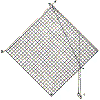By Leslie Hunt
TO FIND THE ALTITUDE OF A KITE

FIG. 69.
THE CLINOGRAPH IN THE POSITION OF THE FIRST OBSERVATION
Sight along AB to the kite, with a plumb bob C free to find a vertical
position. Secure the line with a pin or tack. Plumb bob D remains outside the
row of brads as described in the text.
It is not an easy matter to find the altitude at which a kite flies. A little thought will make it clear that neither the angle at which a kite flies nor the amount of string used will determine the height. In fact, one cannot always determine the height of ascent by knowing both the amount of string and the angle since lateral currents and unequal strata of air do not allow the string to follow any regular curve.
All observations to give correct results must be made from two positions or stations a known distance apart. If the angles at which the kite flies and the distance the stations are apart are known, the altitude may be computed by special methods. But the easiest way is by using what may be called a "clinograph." You can make one easily as follows:
Select one of the end boards of an orange crate, and either rule it into squares or paste a sheet of squared paper on it. Half-inch squares will answer very well. Drive a row of brads along the right-hand edge, putting one brad in each square as shown in Figures 69 and 70.

FIG. 70.
THE CLINOGRAPH AT THE END OF THE SECOND OBSERVATION
The plumb C is held in place while the plumb D is released as described in
the text. The squares in this case are considered as being ten feet
square. The plumb lines intersect at a point between the eighth and ninth
square from the row of brads. The distance represented is therefore nearly
86 feet which represents the height the kite is above the observer. That
would be about 90 feet from the ground. The squares may be given any value
desired. In this case, if the squares are taken as 25 feet, the fifteenth
square (sixteenth brad) would represent a base line of 375 feet, and the
intersection would read off 8 1/2 X 25=212.5 feet, plus the height of the
observer, (say 4.5 feet) giving 217 feet for the altitude of the kite. Do
not be dissappointed in this device. Kite altitudes are nearly always
overestimated. When a great deal of string is used, a single kite is
seldom higher than a fifth of the length of the string.
Select a piece of braided fish line 3 feet long and tie the middle to the brad in the upper right-hand corner. Attach iron nuts or other small heavy objects to each end of the string. Let one string and nut hang outside the brads, and the other inside just clearing the board.
To make an observation, let the strings hang free as plumb lines. Sight along the top edge of the board, AB, to the kite. When the plumb line nearest you finds its position, secure it taut along the face of the board by means of a tack. Without moving the kite, walk directly toward it for some distance, say 150 feet, and swing the other plumb line under the fifteenth brad from the top (that is, the sixteenth brad in the row) and observe as before.
The intersection of the two strings will indicate on the board the altitude the kite is flying. You will note that the squares in this case are taken as 10 feet, since you allowed 15 squares for the 150-foot line between the observations. Then if the strings intersect or cross at 8 1/2 squares to the left of the line of brads, the kite is flying at an altitude of 85 feet.
There are two sources of error; namely, imperfections of the instrument, and imperfections in the observations. Since the plumb lines do not form their angles from the same brad, a slight error creeps into the plotting but the error cannot be greater than the distance the brads are apart. The width of the strings also makes another error probable, but this may be offset by reading the right of one string and the left of the other, and taking an average. Be careful that the strings do not scrape on the board and that the wind does not blow the nuts while making an observation.
The ground between the observation stations may not be level. One should avoid broken country for observations, or else allow for the difference in the altitudes when the final plotting is made. A clinograph may have adjustments to take care of these errors, but a little judgment will correct such errors as are likely to arise. Figures 69 and 70 show the clinograph in the positions of the two observations and also the method for reading the altitude of the kite directly from the plotted readings.